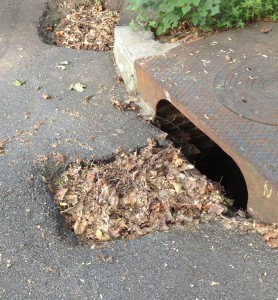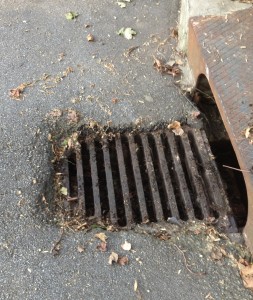Have You Checked Your Storm Drain Lately?
by Peggy Berg, Traffic/Transportation & Sidewalks chair

We live on hills and are shaded by trees. Which means rainwater runs past our homes, picking up leaves and debris, and goes down our many many storm drains, clogging the drains as it flows. I met Riley, from Atlanta’s Watershed Department, at the storm drain on Bellevue because I thought it needed a grate. He brought his shovel and in minutes dug through composted leaves to show me the existing grate, which was completely blocked. It shouldn’t have been a surprise, I’ve seen the drain on Briarcliff Terrace blocked by everything from leaf bags to old fence parts to basketballs.
Storm drains that are not maintained fill with debris and allow flooding, which can be severe. Although the City has emergency crews to deal with blocked drains and pays special attention to catch basins that flood regularly, they can neither keep ahead of random blockages nor predict where they will occur. Once the drain is blocked and floods, surrounding property owners have an expensive and messy problem.
As a prudent part of maintaining your home, look for your storm drain, check it regularly, and keep it clear. A storm drain should have a clear and visible grate (catch basin cover) which is a metal grill. The grates sit on the drain and are held in place by gravity. They get clogged with leaves, other debris, toys, and other trash up to and including full yard waste bags. Sometimes the grates get dislodged or shifted and need to be pushed back in place.
To clear a storm drain, dig it out with a rake and shovel. You will be working mostly with leaves and compost suitable for a yard bag or to use as mulch. It is not difficult to rake the grates and put the debris in a yard bag. If the grate is missing or is beyond your ability to clear, call the City Watershed Department for assistance at 404.330.6340.

